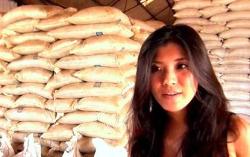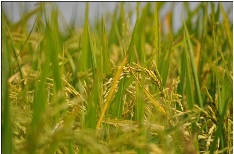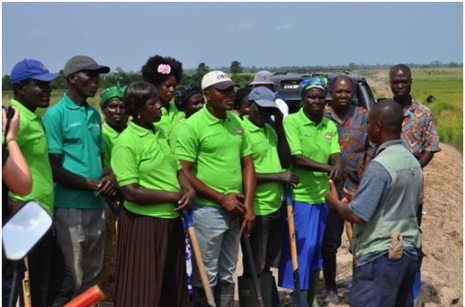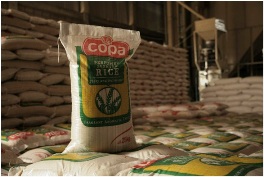- Article
- Other
Dispatches from Ghana: (1) Breaking the Cycle of Poverty among Rice Farmers
August 26, 2013
In November 2012, Junko Tashiro traveled to Ghana under an Acumen Global Fellowship to take part in an innovative social enterprise aimed at transforming the local rice industry and breaking the cycle of rural poverty. Tashiro’s first report from the field combines nostalgic scenes of the good life on a modern Japanese farm with a clear-eyed look at the plight of Ghana’s rice farmers.
* * *
I was extremely close to my grandfather as a child, and I always looked forward impatiently to summer vacation, when my family took its annual trip to Miyagi to visit my grandparents. As the Shinkansen bullet train sped north, leaving hot, muggy Tokyo behind, I would gaze out the window at the rice paddies. Decked out in that rich, vibrant golden green that defies description, they seemed to stretch out forever and ever.

The vegetables we ate in the country were always fresh from the field, where they had been raised by my grandfather with loving care. I could never stand the pale, bland tomatoes that one saw piled in perfect rows in Tokyo supermarkets, but I willingly ate the sweet, bright-red tomatoes that came from my grandfather’s fields. It was thanks to my grandfather that I learned to love vegetables.
But the best treat of all was the rice from my grandfather’s paddy. A plain bowl of steamed rice, all plumped up and glistening, seemed like a dish fit for royalty. It nearly spoiled me for other rice. (Even today, I’m pretty fussy about the rice I eat.)
Life Comes Full Circle
I remember one day when my grandfather made me a grilled rice ball for a mid-afternoon snack. It was a great big thing slathered in miso paste and beautifully browned on the outside. Enticed by the aroma, I reached out to grab one without thinking. My grandfather gently restrained me; he had something he wanted me to hear. He told me about the rural poverty that had forced young Japanese men like him to enlist in the army and go to war. He talked about how the nation had rebuilt after the war’s devastation, embarked on a period of rapid economic growth, and developed into one of the world’s most advanced economies in a few decades’ time.
“Today,” he said, “most Japanese people take all the good things they have for granted, but if you take a look at other parts of the world, you’ll realize how blessed you are.” He told me that I should always be thankful and never forget that, while I was eating my fill of all my favorite foods, millions of people around the world were going hungry. He also admonished me to think about what I could and should do to help those less fortunate once I grew up.
I approached my snack a little more thoughtfully than usual that day. Of course, I grabbed it and ate my fill, but I chewed each bite carefully and respectfully, savoring each grain of rice. Looking back, I realize that my interest in the global poverty issue all stems from that afternoon with my grandfather.
Now here I am, almost 25 years later, cultivating rice in Ghana as an Acumen Global Fellow. It’s not something I would ever have imagined myself doing. Yet it feels so right that I can’t help but believe that this is what fate had in store for me all along.
Rural Poverty and a Market Disconnect
Rice is a familiar food item in Japan, having been a staple of the Japanese diet since ancient times. But when we look at other countries, we realize that rice is often perceived in quite different ways.

In Ghana, for instance, people have traditionally relied on starchy root vegetables like cassava and yams, or in some cases plantains, as their main source of calories, and these foods still serve as staples in rural areas. In the cities, however, rice is an important and rapidly expanding component of the Ghanaian diet.
This trend is attributed to changing lifestyles accompanying rising incomes and the increasing concentration of the middle class in Ghana’s major cities, such as the capital of Accra and the second-largest city of Kumasi. A growing number of urbanites seem to share the opinion of my Ghanaian colleague that “rice is a cool food”—high in nutrition, healthy, and easy to cook. As a result, demand has been rising at an annual rate of 40%.
The important thing to note is that this new consumer demand is almost entirely for premium rice. Although the taste for rice is a relatively new phenomenon, Ghanaian urbanities are already pretty particular about the rice they eat. Unlike the Japanese, they prefer long-grain rice. They insist that the grains be whole and intact, not broken in the milling process, and they won’t stand for rice that is mixed with inferior varieties. They prefer their rice factory-packed in neatly labeled plastic packages. And above all, they like the aromatic varieties, such as Thai jasmine rice. Unfortunately, Ghana’s farmers lack the skills and capacity to meet this end consumers’ demand for premium rice, and as a result the country depends on imports from Asia and elsewhere to meet more than 70% of domestic demand. Ghana currently imports upwards of $500 million worth of rice annually.
Yet Ghana is an agrarian economy, like most sub-Saharan nations in Africa. The majority of its citizens earn their living from farming. So, why should Ghana have to depend on other countries to meet its domestic demand for rice?
The biggest reason is that the majority of Ghanaian farmers are smallholders cultivating tiny plots that generate little income. They lack ready cash to buy fertilizers, herbicides, and other essential inputs. Some resort to borrowing money at high interest rates and are still unable to invest the minimum required to make farming profitable.
Rice farming poses special challenges for these smallholders. The premium seed varieties are expensive and are often unavailable in the open market in any case. Without access to irrigation facilities, many farmers have to gamble on precipitation to support this water-intensive crop. Moreover, rice cultivation is a science, and Ghanaian farmers have relatively few opportunities to learn the sophisticated techniques needed to maximize yield. As a result, rice farming in Ghana is plagued by missteps and inefficiencies.
Rice farming is also extremely labor intensive unless one has access to combine harvesters and other machinery. Of course, buying such equipment is out of the question for most Ghanaian farmers, and rental raises its own problems. Because demand is rising faster than supply, rental rates are high, and farmers sometimes find themselves waiting weeks for the equipment they have reserved. Some give up and hire seasonal workers to ensure the crop is harvested, while others wait, only to find that the crop has been damaged or ruined in the meantime.
The combined effect of these problems is that crop yield among Ghana’s small rice farms is 40% below the global average.
The travails of Ghana’s rice smallholders continue beyond the harvest. Farmers lacking access to combine harvesters or threshing machines must remove the chaff manually by pounding. This tends to crush or break the kernels, leaving farmers with less rice to sell and making what remains ill fit for the urban consumer market. The alternative is to sell unthreshed rice to private traders in the open market—in other words, middlemen and “market mommies”—at unfairly low prices. After more than four months sweating in the fields and struggling to make ends meet until the harvest, the farmers are lucky if their proceeds cover their expenses.
As a result of these circumstances, the domestic market for premium rice is largely closed to domestic producers, who remain locked in a hopeless cycle of poverty. Policymakers also worry that this disconnect between local production and consumption could jeopardize Ghana’s food security in the long run.
GADCO: Breaking the Vicious Circle
(Film by Acumen)
GADCO (Global Agri-Development Company) was founded to address the two important and interrelated problems of food security and the cycle of poverty in Ghana. Social entrepreneurs Iggy Bassi and Toks Abimbola, the co-founders of GADCO, realized that Ghana had plenty of potential for agricultural production but lacked the system needed to unlock that potential. So they began working to build such a system from scratch.
Before GADCO came on the scene, Ghana’s rice production value chain was extremely fragmented. Even if small farmers were able to get hold of premium rice seeds, they often lacked access to milling facilities and were forced to sell their harvest to private traders, who bought the rice as cheaply as possible in order to make a profit after paying the high cost of milling. Next, the processed rice went through various distributors before reaching end consumers, and the distributors naturally sought to maximize their own profits by buying as cheaply as possible. Ultimately it was the producers, or the smallholders, who got squeezed. GADCO saw that the only way to boost producers’ revenues was to reform the entire system. To connect producers directly to the end-consumer market, GADCO built a vertically integrated rice production value chain encompassing each phase of the business, from R&D to end-market distribution.

Since its beginnings in an empty field in a rural village four years ago, GADCO has grown into Ghana’s largest commercial rice producer, growing premium rice for the end-consumer market year-round on about 1,000 hectares of farmland. Its large-scale nucleus farm carries out R&D to develop improved, high-yield varieties and continually explore ways of maximizing productivity, such as by introducing cutting-edge Brazilian technology designed for large farm operations.
After harvesting, the rice is milled, packaged, and labeled at a large, modern processing facility (as of May 2013, GADCO was still using a third-party mill, owing to volume considerations, but with production capacity swelling, construction of GADCO’s own mill is under way and should be completed soon.) The rice is then distributed by Finatrade, which boasts the most extensive retail network of any rice distributor in Ghana, and sold on the domestic premium market. GADCO is the only agri-food business in Ghana that integrates the rice value chain in this holistic way.
In Africa and South America, large agribusinesses have come under harsh criticism for “land grabbing.” But GADCO’s large-scale, highly mechanized, high-tech operation has taken a whole new approach to farm consolidation. The key is long-term contracts with local communities.

The vast majority of land in Ghana’s rural communities is totally unused and undeveloped. The local residents lack the know-how to make the best use of these vast land resources. When seeking to expand, they generally resort to slash-and-burn techniques that quickly leave the land barren. GADCO’s solution is to sign 30-year land leases with local communities so the farmland can be managed as part of the extension of GADCO’s own nucleus farm in an efficient and environmentally sustainable manner. Through this approach, GADCO aims to improve villagers’ living standards over the long term.
What really sets GADCO apart is its practice of revenue sharing. GADCO returns a share of the profits from its rice operations to the community for distribution among all the households and investment in schools and hospitals. It also contributes to the community’s long-term development by creating jobs and providing opportunities for education and training.
Mission: Launch Copa Connect

Unfortunately, this approach takes time, since each new farm plot requires the consent of everyone in the community. Relying on this system alone, it would take many years of dialogue and hefty capital investment to replace all imported rice with domestic rice—an important step toward food security.
For this reason, GADCO is also working to integrate rice smallholders into its value chain as producers while helping them realize their own production potential. In this way, GADCO hopes not only to accelerate the pace of expansion of its rice production but also to pursue its core mission of breaking the cycle of rural poverty. GADCO’s hybrid business model, connecting its large-scale nucleus farm operations with smallholder producers, promises to transform Ghana’s economy and society.
As an Acumen Global Fellow, I was sent to Ghana to launch the Copa Connect smallholder program—named for GADCO’s own rice brand, Copa, and the concept of connecting rice smallholders with the end-consumer market. The project’s goals are ambitious: design a business model, define an operating blueprint, develop partnerships required for implementation, secure all resources needed for actual operations, and, finally, begin work on the introduction of smallholder-centric technologies with the goal of signing on 1,000 smallholders by the end of 2013 and eight times that number within the next five years.
It’s an opportunity of a lifetime, but I wonder how much I can contribute to such an enterprise. True, I have a longstanding interest in rice, but I have never launched a business, and my knowledge of agribusiness, rice production, and Ghanaian farmers is minimal. Something tells me this is going to be a long, long journey.
